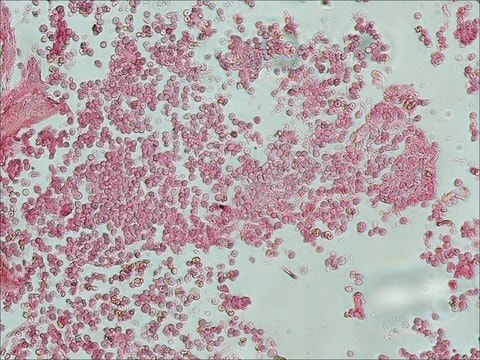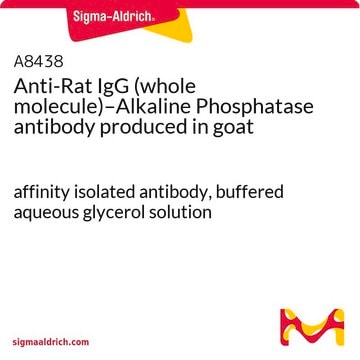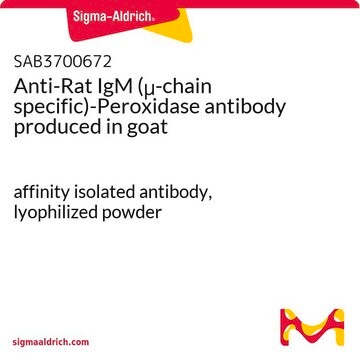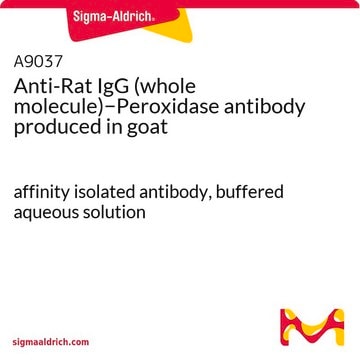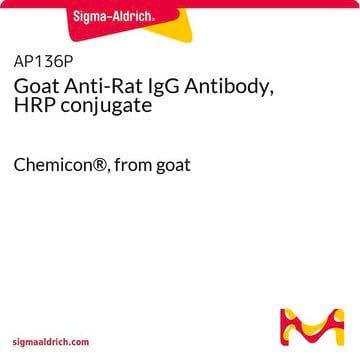일반 설명
Monoclonal anti-Rat IgM (mouse IgG1 isotype) is derived from the RTM-32 hybridoma produced by the fusion of mouse myeloma cells and splenocytes from BALB/c mice immunized with a rat IgM myeloma preparation. Immunoglobulin M (IgM) is the first immunoglobulin to be produced, which is detected as early as 9 weeks of gestation. It has a pentameric structure, in which monomers are linked together by disulfide bonds. IgM is produced by B cells and is expressed in high concentrations in blood.
Rat immunoglobulins have seven distinct classes, namely, IgM, IgA, IgE, IgG1, IgG2a, IgG2b and IgG2c. Rat IgMs have been implicated in complement activation . Rat IgMs against target proteins are often used as primary antibodies in various research applications. Thus, secondary anti-rat IgM is a useful tool for the analysis of target proteins
Monoclonal Anti-Rat IgM antibody is specific for an epitope present on the heavy chain of rat IgM. By immunoblotting, the antibody detects the denatured-reduced heavy chain molecule of rat IgM (μ-chain). The product recognizes rat IgMs derived from normal serum or myeloma proteins, but does not detect other rat immunoglobulins. In assays such as indirect ELISA and dot blot, the antibody weakly associates with guinea pig immunoglobulins. The product does not bind to IgG or serum preparations obtained from bovine, cat, chicken, dog, goat, horse, human, mouse, pig, rabbit, or sheep.
특이성
Monoclonal anti-Rat IgM recognizes an epitope located on the heavy chain of rat IgM. The antibody detects the rat IgM derived from normal serum or myeloma proteins, but not the other rat immunoglobulins.
면역원
Rat IgM myeloma preparation
애플리케이션
Monoclonal Anti-Rat IgM antibody is suitable for use in:
- indirect ELISA (1:1,000)
- immunocytochemistry
- immunohistochemistry
- dot blot
- immunoblotting
생화학적/생리학적 작용
Immunoglobulin (IgM) serves as the first line of defense during microbial infections. It serves as the antigen receptor of naive B cells. Secreted IgM (sIgM) is implicated in B cell maturation and complement activation. Detection of IgM antibodies in a neonate′s serum may indicate intrauterine infection (e.g. congenital rubella syndrome). Development of anti-donor IgM after combined liver-kidney transplantation provides a graft-protecting effect. Anti-Human IgM (μ-specific) antibodies are used in the detection of IgM-associated pathologies, such as selective IgM immunodeficiency (SIgMID) and the hyper immunoglobulin M (hyper-IgM or HIGM) syndromes.
물리적 형태
The product is provided as ascites fluid with 15 mM sodium azide as a preservative.
저장 및 안정성
For continuous use, store at 2-8 °C. For extended storage, freeze in working aliquots. Repeated freezing and thawing is not recommended. Storage in "frost-free" freezers is not recommended. If slight turbidity occurs upon prolonged storage, clarify the solution by centrifugation before use.
면책조항
Unless otherwise stated in our catalog or other company documentation accompanying the product(s), our products are intended for research use only and are not to be used for any other purpose, which includes but is not limited to, unauthorized commercial uses, in vitro diagnostic uses, ex vivo or in vivo therapeutic uses or any type of consumption or application to humans or animals.
